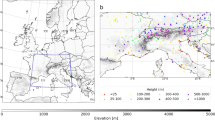Abstract
In response to the needs of improving hurricane forecasts, we have built an experimental version of the operational Hurricane Weather Research and Forecasting Model (HWRF), which is based on the Weather Research and Forecasting Nonhydrostatic Mesoscale Model of the National Oceanic and Atmospheric Administration (NOAA). The experimental HWRF (HWRFx) is adopted to study the intensity change problem at the highest possible resolutions with the existing computing facility, using moving nests to focus the model resolution in the vicinity of the storms. Although this is at an early stage of development, results from real-time experiments in the 2008 hurricane season show that the HWRFx is generally comparable to the NOAA operational models, in terms of the accuracy of both track and intensity forecasts. The HWRFx, however, has a negative bias in the intensity forecasts as opposed to the positive biases of the NOAA operational models. We present in this article a brief description of the HWRFx and its performance during the 2008 hurricane season in comparison with the NOAA operational models.







Similar content being viewed by others
References
Arakawa A, Schubert WH (1974) Interaction of a cumulus cloud ensemble with the large scale environment. Part I. J Atmos Sci 31:674–701
Bender MA, Ginis I (2000) Real case simulation of hurricane-ocean interaction using a high-resolution coupled model: effects on hurricane intensity. Mon Wea Rev 128:917–946
Bender MA, Ginis I, Tuleya RE, Thomas B, Marchok T (2007) The operational GFDL coupled hurricane-ocean prediction system and a summary of its performance. Mon Wea Rev 135:3965
Bernardet L (eds), Gopalakrishnan S, Liu Q, Marchok T, Sheinin D, Surgi N, Tuleya R, Yablonsky R, Zhang X (2010) Hurricane Weather Research and Forecasting (HWRF) Model Scientific Documentation. DTC Hurricane WRF Documents. http://www.dtcenter.org/HurrWRF/users/docs/scientific_documents/HWRF_final_2-2_cm.pdf
Dudhia J (1989) Numerical study of convection observed during the winter monsoon experiment using a mesoscale two-dimensional model. J Atmos Sci 46:3077–3107
Ek MB, Mitchell KE, Lin Y, Rogers E, Grunmann P, Koren V, Gayno G, Tarpley JD (2003) Implementation of Noah land surface model advances in the NCEP operational mesoscale Eta model. J Geophys Res 108(D22):8851. doi:10.1029/2002JD003296
Ferrier BS, Lin Y, Black T, Rogers E, DiMego G (2002) Implementation of a new grid-scale cloud and precipitation scheme in the NCEP Eta model. Preprints, 15th conference on numerical weather prediction, San Antonio, TX, American Meteorological Society, pp 280–283
Gopalakrishnan SG, Surgi N, Tuleya R, Janjic Z (2006) NCEP’s two-way-interactive-moving-nest NMM-WRF modeling system for hurricane forecasting. Preprints, 27th Conference on Hurricanes and Tropical Meteorology, Monterey, CA, American Meteorological Society, Ar. 7A.3
Hong S-Y, Pan H-L (1996) Nonlocal boundary layer vertical diffusion in a medium-range forecast model. Mon Wea Rev 124:2322–2339
Hong S-Y, Pan H-L (1998) Convective trigger function for a mass-flux cumulus parameterization scheme. Mon Wea Rev 129:1164–1178
Hou Y-T, Moorthi S, Campana KA (2002) Parameterization of solar radiation transfer in the NCEP models. NCEP Office Note, No. 441
Janjic Z, Gerrity JP Jr, Nickovic S (2001) An alternative approach to nonhydrostatic modeling. Mon Wea Rev 126:2599–2620
Kurihara Y, Bender MA, Ross RJ (1993) An initialization scheme of hurricane models by vortex specification. Mon Wea Rev 121:2030–2045
Kurihara Y, Bender MA, Tuleya RE, Ross RJ (1995) Improvements in the GFDL Hurricane Prediction System. Mon Wea Rev 123:2791–2801
Kurihara Y, Tuleya RE, Bender MA (1998) The GFDL Hurricane Prediction System and its performance in the 1995 hurricane season. Mon Wea Rev 126:1306–1322
Lacis AA, Hansen JE (1974) A parameterization for the absorption of solar radiation in the earth’s atmosphere. J Atmos Sci 31:118–133
Liu Q, Surgi N, Lord S, Wu W-S, Parrish D, Gopalakrishnan S, Waldrop J, Gamache J (2006) Hurricane Initialization in HWRF Model. Preprints, 27th conference on Hurricanes and Tropical Meteorology, Monterey, CA, American Meteorological Society, Ar. 8A.2
Mlawer EJ, Taubman SJ, Brown PD, Iacono MJ, Clough SA (1997) Radiative transfer for inhomogeneous atmosphere: RRTM, a validated correlated-k model for the long-wave. J Geophys Res 102(D14):16663–16682
Moon I, Ginis I, Hara T, Thomas B (2007) Physics-based parameterization of air sea momentum flux at high wind speeds and its impact on hurricane intensity predictions. Mon Wea Rev 135:2869–2878
Schwarzkopf MD, Fels S (1991) The simplified exchange method revisited: an accurate, rapid method for computation of infrared cooling rates and fluxes. J Geophys Res 96(D5):9075–9096
Sirutis JJ, Miyakoda K (1990) Subgrid scale physics in 1-month forecasts. Part I: experiment with four parameterization packages. Mon Wea Rev 118(5):1043–1064
Tuleya RE (1994) Tropical storm development and decay. Sensitivity to surface boundary conditions. Mon Wea Rev 122:291–304
Tuleya RE (2008) Hurricane model transitions to operations. Joint Hurricane Testbed Report. http://www.nhc.noaa.gov/jht/07-09reports/Tuleya_yr1_annualrpt08.pdf
Zeng X, Zhao M, Dickinson RE (1998) Intercomparison of bulk aerodynamic algorithms for the computation of sea surface fluxes using TOGA COARE and TAO data. J Climate 11:2628–2644
Zhao QY, Carr FH (1997) A prognostic cloud scheme for operational NWP models. Mon Wea Rev 125:1931–1953
Acknowledgments
Dr. Jian-Wen Bao, Robert Tuleya, Vijay Tallapragada, Steven Koch, Stephen Lord, and many other colleagues at the NOAA AOML, ESRL, and EMC have contributed to the development of the HWRFx model with useful comments, inspiring suggestions and enthusiastic support. Mr. Thiago Quirino and Ms. Varsha Sainani helped the operation of the HWRFx during the 2008 hurricane season with system automation and data visualization. The Editor in Chief, Dr. T. S. Murty, and two anonymous reviewers have provided insightful comments leading to the improvement of the manuscript. This work is sponsored by the NOAA Hurricane Forecast Improvement Project.
Author information
Authors and Affiliations
Corresponding author
Rights and permissions
About this article
Cite this article
Yeh, KS., Zhang, X., Gopalakrishnan, S. et al. Performance of the experimental HWRF in the 2008 Hurricane Season. Nat Hazards 63, 1439–1449 (2012). https://doi.org/10.1007/s11069-011-9787-7
Received:
Accepted:
Published:
Issue Date:
DOI: https://doi.org/10.1007/s11069-011-9787-7




